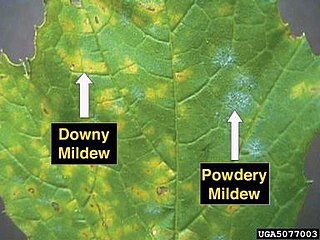
Powdery mildew is a fungal disease that affects a wide range of plants. Powdery mildew diseases are caused by many different species of ascomycete fungi in the order Erysiphales. Powdery mildew is one of the easier plant diseases to identify, as its symptoms are quite distinctive. Infected plants display white powdery spots on the leaves and stems. The lower leaves are the most affected, but the mildew can appear on any above-ground part of the plant. As the disease progresses, the spots get larger and denser as large numbers of asexual spores are formed, and the mildew may spread up and down the length of the plant.

The Marasmiaceae are a family of fungi in the order Agaricales. Basidiocarps are most frequently agarics, but occasionally cyphelloid. According to a 2008 estimate, the family contained 54 genera and 1590 species, but molecular research, based on cladistic analysis of DNA sequences, has led to a more restricted family concept, so that the Marasmiaceae included just 13 genera, and some 1205 species. It was reduced further down in 2020, to 10 genera and about 700 species.

Rhizoctonia solani is a species of fungus in the order Cantharellales. Basidiocarps are thin, effused, and web-like, but the fungus is more typically encountered in its anamorphic state, as hyphae and sclerotia. The name Rhizoctonia solani is currently applied to a complex of related species that await further research. In its wide sense, Rhizoctonia solani is a facultative plant pathogen with a wide host range and worldwide distribution. It causes various plant diseases such as root rot, damping off, and wire stem. It can also form mycorrhizal associations with orchids.
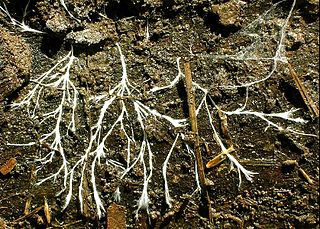
Mycelial cords are linear aggregations of parallel-oriented hyphae. The mature cords are composed of wide, empty vessel hyphae surrounded by narrower sheathing hyphae. Cords may look similar to plant roots, and also frequently have similar functions; hence they are also called rhizomorphs. As well as growing underground or on the surface of trees and other plants, some fungi make mycelial cords which hang in the air from vegetation.
Mycena citricolor is a species of mushroom-forming fungus in the family Mycenaceae. It is a plant pathogen producing leaf spots on coffee plants. This fungus causes the disease commonly known as American Leaf Spot. Mycena citricolor affects coffee plants, primarily in Latin America, but can grow on other plants as well. This fungus can grow on all parts of the coffee plant including the leaves, stems and fruits. When grown on the leaves, Mycena citricolor results in leaves with holes that often fall from the plant.
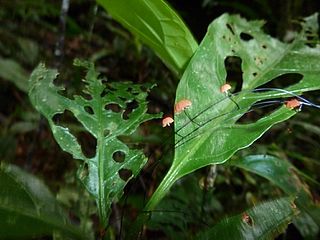
Marasmius crinis-equi is a plant pathogen. It is commonly known as the 'horse hair fungus', and appears on rainforest leaves as a wiry stipe with a delicate fruitbody. The cap of the fruitbody can be up to 4 mm in diameter, and is pale brown.
Thecaphora is a genus of basidiomycote fungus which contains several species of plant pathogens. The widespread genus contained about 57 species in 2008. and held 61 species in 2020.

Marasmius elegans, commonly known as the velvet parachute, is a species of fungus in the family Marasmiaceae. It has a reddish-brown cap, and a whitish stipe with white hairs at the base. It can be found in eucalypt forests in Australia.

Marasmius rotula is a common species of agaric fungus in the family Marasmiaceae. Widespread in the Northern Hemisphere, it is commonly known variously as the pinwheel mushroom, the pinwheel marasmius, the little wheel, the collared parachute, or the horse hair fungus. The type species of the genus Marasmius, M. rotula was first described scientifically in 1772 by mycologist Giovanni Antonio Scopoli and assigned its current name in 1838 by Elias Fries.

Marasmius sasicola is a species of Marasmiaceae fungus known from Kanagawa Prefecture, Japan. First collected in 2000, it was described in 2002 by Haruki Takahashi. The species produces small mushrooms with white caps and very short, very thin black stems. Unlike in other, similar species, the stems enter the plant matter on which the mushroom grows. The six to eight white gills are spread out around the cap, and all of them reach the stem. The flesh has no taste or odour. Found in June, the species grows on dead Sasa leaves, from which it takes its specific epithet.

Kathleen Maisey Curtis, Lady Rigg was a New Zealand mycologist and was a founder of plant pathology in New Zealand.

Marasmius koae is a species of agaric fungus in the family Marasmiaceae. Newly described to science in 2011, it is known only from Hawaiian montane wet forests. It produces small stemless fruit bodies that grow on the rotting wood of the flowering tree koa.
Pluteus aethalus is a species of agaric fungus in the family Pluteaceae. It is found in Cuba. The species was originally named Agaricus aethalus by Miles Joseph Berkeley & Moses Ashley Curtis in 1869, and later transferred to the genus Pluteus by Pier Andrea Saccardo in 1887. It is classified in Pluteus section Celluloderma, subsection Mixtini.
Roridomyces subglobosus is a species of fungus in the genus Roridomyces, family Mycenaceae.
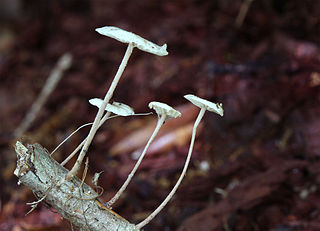
Mycetinis opacus is a species of agaric fungus first described in 1849 by Miles Joseph Berkeley and Moses Ashley Curtis as Marasmius opacus. Andrew Wilson and Dennis Desjardin transferred it to Mycetinis in 2005.
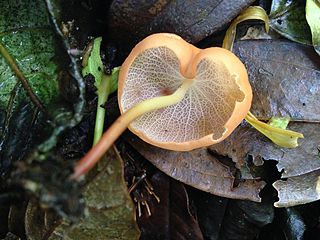
Marasmius cladophyllus is a species of fungus in the family Marasmiaceae. Found in South America and Central America, it was described as new to science by English mycologist Miles Joseph Berkeley in 1856. A characteristic feature of the mushroom is the prominent ventricose (vein-like) pattern of the gills.
Hygrophoropsis purpurascens is a species of fungus in the family Hygrophoropsidaceae. Originally described by Miles Joseph Berkeley and Moses Ashley Curtis in 1869 as Marasmius purpurascens, it was transferred to the genus Hygrophoropsis by Richard Dennis in 1952. It has been collected from Trinidad, Venezuela, Jamaica, and Cuba, where it grows on rotting logs in forests.
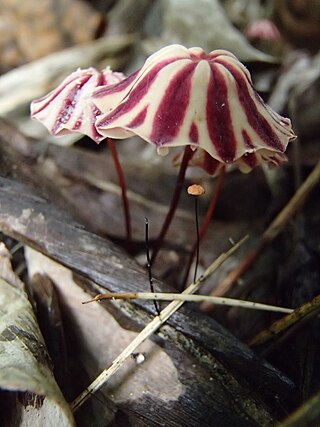
Marasmius tageticolor is a species of agaric fungus in the family Marasmiaceae. Its fruit bodies have striped red and white caps. It is found in Mexico, Central America, and South America, where it grows on twigs.
Cerocorticium molle is a species of crust fungus in the family Meruliaceae.

Rhizomarasmius epidryas is one of a group of mushrooms formerly in the genus Marasmius. It grows amongst dwarf shrubs of the genus Dryas in arctic or high mountain environments.













